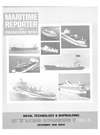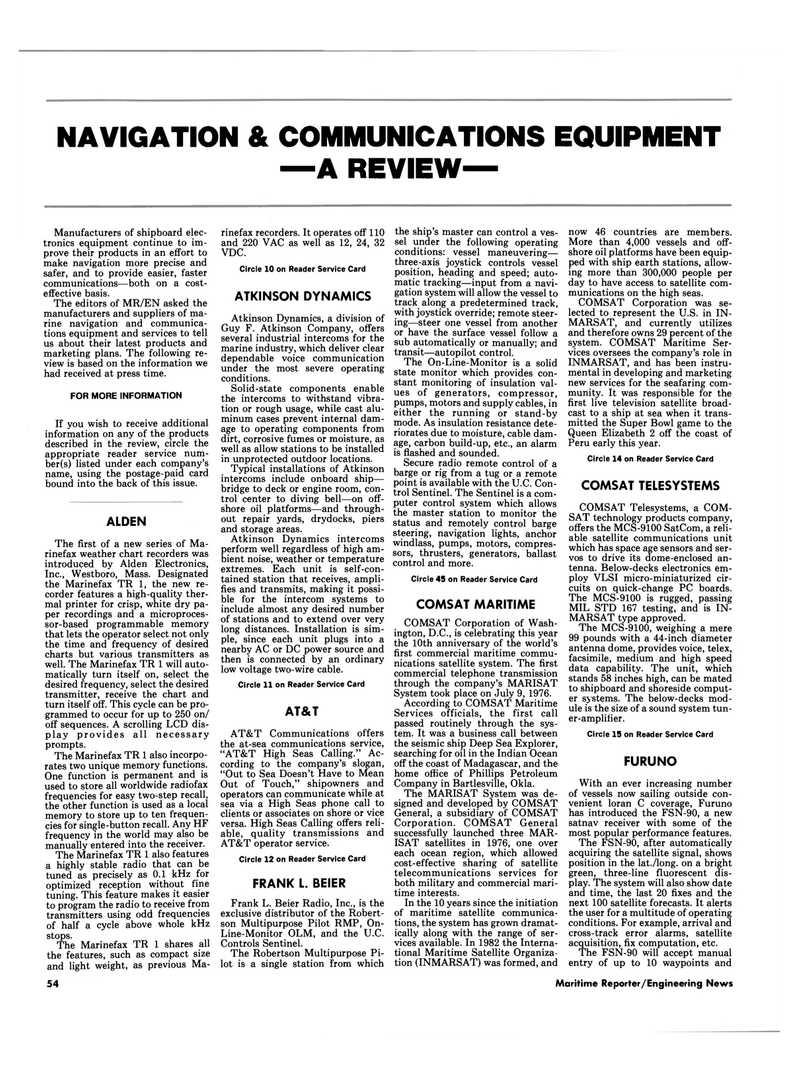
Page 52: of Maritime Reporter Magazine (December 1986)
Read this page in Pdf, Flash or Html5 edition of December 1986 Maritime Reporter Magazine
NAVIGATION & COMMUNICATIONS EQUIPMENT —A REVIEW—
Manufacturers of shipboard elec- tronics equipment continue to im- prove their products in an effort to make navigation more precise and safer, and to provide easier, faster communications—both on a cost- effective basis.
The editors of MR/EN asked the manufacturers and suppliers of ma- rine navigation and communica- tions equipment and services to tell us about their latest products and marketing plans. The following re- view is based on the information we had received at press time.
FOR MORE INFORMATION
If you wish to receive additional information on any of the products described in the review, circle the appropriate reader service num- ber^) listed under each company's name, using the postage-paid card bound into the back of this issue.
ALDEN
The first of a new series of Ma- rinefax weather chart recorders was introduced by Alden Electronics,
Inc., Westboro, Mass. Designated the Marinefax TR 1, the new re- corder features a high-quality ther- mal printer for crisp, white dry pa- per recordings and a microproces- sor-based programmable memory that lets the operator select not only the time and frequency of desired charts but various transmitters as well. The Marinefax TR 1 will auto- matically turn itself on, select the desired frequency, select the desired transmitter, receive the chart and turn itself off. This cycle can be pro- grammed to occur for up to 250 on/ off sequences. A scrolling LCD dis- play provides all necessary prompts.
The Marinefax TR 1 also incorpo- rates two unique memory functions.
One function is permanent and is used to store all worldwide radiofax frequencies for easy two-step recall, the other function is used as a local memory to store up to ten frequen- cies for single-button recall. Any HF frequency in the world may also be manually entered into the receiver.
The Marinefax TR 1 also features a highly stable radio that can be tuned as precisely as 0.1 kHz for optimized reception without fine tuning. This feature makes it easier to program the radio to receive from transmitters using odd frequencies of half a cycle above whole kHz stops.
The Marinefax TR 1 shares all the features, such as compact size and light weight, as previous Ma- rinefax recorders. It operates off 110 and 220 VAC as well as 12, 24, 32
VDC.
Circle 10 on Reader Service Card
ATKINSON DYNAMICS
Atkinson Dynamics, a division of
Guy F. Atkinson Company, offers several industrial intercoms for the marine industry, which deliver clear dependable voice communication under the most severe operating conditions.
Solid-state components enable the intercoms to withstand vibra- tion or rough usage, while cast alu- minum cases prevent internal dam- age to operating components from dirt, corrosive fumes or moisture, as well as allow stations to be installed in unprotected outdoor locations.
Typical installations of Atkinson intercoms include onboard ship— bridge to deck or engine room, con- trol center to diving bell—on off- shore oil platforms—and through- out repair yards, drydocks, piers and storage areas.
Atkinson Dynamics intercoms perform well regardless of high am- bient noise, weather or temperature extremes. Each unit is self-con- tained station that receives, ampli- fies and transmits, making it possi- ble for the intercom systems to include almost any desired number of stations and to extend over very long distances. Installation is sim- ple, since each unit plugs into a nearby AC or DC power source and then is connected by an ordinary low voltage two-wire cable.
Circle 11 on Reader Service Card
AT&T
AT&T Communications offers the at-sea communications service, "AT&T High Seas Calling." Ac- cording to the company's slogan, "Out to Sea Doesn't Have to Mean
Out of Touch," shipowners and operators can communicate while at sea via a High Seas phone call to clients or associates on shore or vice versa. High Seas Calling offers reli- able, quality transmissions and
AT&T operator service.
Circle 12 on Reader Service Card
FRANK L. BEIER
Frank L. Beier Radio, Inc., is the exclusive distributor of the Robert- son Multipurpose Pilot RMP, On-
Line-Monitor OLM, and the U.C.
Controls Sentinel.
The Robertson Multipurpose Pi- lot is a single station from which the ship's master can control a ves- sel under the following operating conditions: vessel maneuvering— three-axis joystick controls vessel position, heading and speed; auto- matic tracking—input from a navi- gation system will allow the vessel to track along a predetermined track, with joystick override; remote steer- ing—steer one vessel from another or have the surface vessel follow a sub automatically or manually; and transit—autopilot control.
The On-Line-Monitor is a solid state monitor which provides con- stant monitoring of insulation val- ues of generators, compressor, pumps, motors and supply cables, in either the running or stand-by mode. As insulation resistance dete- riorates due to moisture, cable dam- age, carbon build-up, etc., an alarm is flashed and sounded.
Secure radio remote control of a barge or rig from a tug or a remote point is available with the U.C. Con- trol Sentinel. The Sentinel is a com- puter control system which allows the master station to monitor the status and remotely control barge steering, navigation lights, anchor windlass, pumps, motors, compres- sors, thrusters, generators, ballast control and more.
Circle 45 on Reader Service Card
COMSAT MARITIME
COMSAT Corporation of Wash- ington, D.C., is celebrating this year the 10th anniversary of the world's first commercial maritime commu- nications satellite system. The first commercial telephone transmission through the company's MARISAT
System took place on July 9, 1976.
According to COMSAT Maritime
Services officials, the first call passed routinely through the sys- tem. It was a business call between the seismic ship Deep Sea Explorer, searching for oil in the Indian Ocean off the coast of Madagascar, and the home office of Phillips Petroleum
Company in Bartlesville, Okla.
The MARISAT System was de- signed and developed by COMSAT
General, a subsidiary of COMSAT
Corporation. COMSAT General successfully launched three MAR-
ISAT satellites in 1976, one over each ocean region, which allowed cost-effective sharing of satellite telecommunications services for both military and commercial mari- time interests.
In the 10 years since the initiation of maritime satellite communica- tions, the system has grown dramat- ically along with the range of ser- vices available. In 1982 the Interna- tional Maritime Satellite Organiza- tion (INMARSAT) was formed, and now 46 countries are members.
More than 4,000 vessels and off- shore oil platforms have been equip- ped with ship earth stations, allow- ing more than 300,000 people per day to have access to satellite com- munications on the high seas.
COMSAT Corporation was se- lected to represent the U.S. in IN-
MARSAT, and currently utilizes and therefore owns 29 percent of the system. COMSAT Maritime Ser- vices oversees the company's role in
INMARSAT, and has been instru- mental in developing and marketing new services for the seafaring com- munity. It was responsible for the first live television satellite broad- cast to a ship at sea when it trans- mitted the Super Bowl game to the
Queen Elizabeth 2 off the coast of
Peru early this year.
Circle 14 on Reader Service Card
COMSAT TELESYSTEMS
COMSAT Telesystems, a COM-
SAT technology products company, offers the MCS-9100 SatCom, a reli- able satellite communications unit which has space age sensors and ser- vos to drive its dome-enclosed an- tenna. Below-decks electronics em- ploy VLSI micro-miniaturized cir- cuits on quick-change PC boards.
The MCS-9100 is rugged, passing
MIL STD 167 testing, and is IN-
MARSAT type approved.
The MCS-9100, weighing a mere 99 pounds with a 44-inch diameter antenna dome, provides voice, telex, facsimile, medium and high speed data capability. The unit, which stands 58 inches high, can be mated to shipboard and shoresiide comput- er systems. The below-decks mod- ule is the size of a sound system tun- er-amplifier.
Circle 15 on Reader Service Card
FURUNO
With an ever increasing number of vessels now sailing outside con- venient loran C coverage, Furuno has introduced the FSN-90, a new satnav receiver with some of the most popular performance features.
The FSN-90, after automatically acquiring the satellite signal, shows position in the lat./long. on a bright green, three-line fluorescent dis- play. The system will also show date and time, the last 20 fixes and the next 100 satellite forecasts. It alerts the user for a multitude of operating conditions. For example, arrival and cross-track error alarms, satellite acquisition, fix computation, etc.
The FSN-90 will accept manual entry of up to 10 waypoints and 54 Maritime Reporter/Engineering News

 51
51

 53
53
